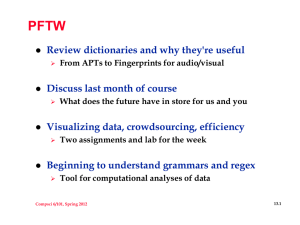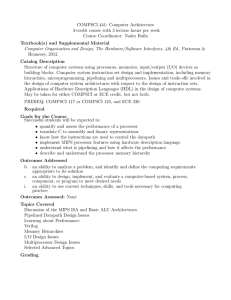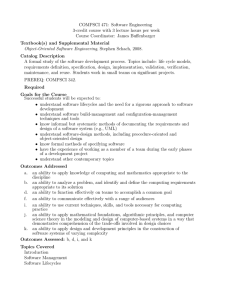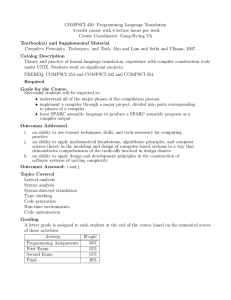Today’s topics Virtual Environment for Computing Upcoming Reading
advertisement
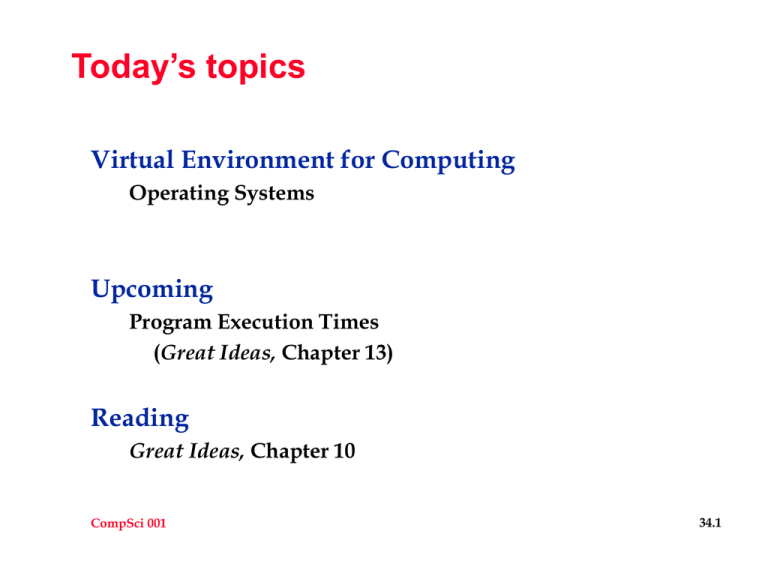
Today’s topics Virtual Environment for Computing Operating Systems Upcoming Program Execution Times (Great Ideas, Chapter 13) Reading Great Ideas, Chapter 10 CompSci 001 34.1 The Problem The Raw Machine Provides a Hostile Environment Imagine program in machine language (on real machine). Machine Language Program for MIPS Machine [00400000] [00400004] argv [00400008] envp [0040000c] [00400010] [00400014] [00400018] [0040001c] 8fa40000 lw $4, 0($29) 27a50004 addiu $5, $29, 4 ; lw $a0, 0($sp) ; addiu $a1, $sp, 4 # 24a60004 addiu $6, $5, 4 ; addiu $a2, $a1, 4 # 00041080 00c23021 0c000000 3402000a 0000000c sll $2, $4, 2 ; addu $6, $6, $2 ; jal 0x00400020 [main]; ori $2, $0, 10 ; syscall ; sll $v0, $a0, 2 addu $a2, $a2, $v0 jal main li $v0 10 syscall Imagine doing disk I/O directly: disk description controlling Heads; timing keeping track of where things are stored dealing with Errors CompSci 001 34.2 The Problem Other I/O Keeping track of memory (RAM) Multiple tasks Multiple users Sharing the CPU Keyboard Screen Communications Multiple tasks Multiple users The User Interface Problem For the computer professional only? For the lay person The Graphical User Interface o Computation to support this? CompSci 001 34.3 Historical Perspective Early Years Early 1960's machines: Almost Bare Mid 1960's Machines: Early Batch Operating Systems Multiprogramming Systems Time Sharing Lab Computers Had Major Theme: CPU Time Precious Ease of use: very low priority Graphical User Interface too costly (and not yet invented) This perspective faded with time and began to disappear with advent of the microprocessor: Cheap CPU time. CompSci 001 34.4 Historical Perspective Later Years Microprocessor in late 70’s PC's in early 80’s: Operating Systems for PC Apple: Macintosh (Xerox PARC) Workstations o UNIX -- AT&T: License Wars -- LINUX Major Change: Lower Costs Whole new audience User Interface o Essential for non pros o Affordable (cpu cycles to burn) Whole new competitive environment Volume! CompSci 001 34.5 Role of the Operating System 1. Processor Management (Multiprogramming = sharing) 1. 2. I/O Systems 1. 2. 3. 3. Windowing Systems / GUIs File Systems (use of your hard disk) Communications/Networking Memory (RAM) Management 1. 2. 4. Several virtual machines Sharing Memory Simulating Additional Memory (Virtual Memory) Software Environments Administration/Accounting Compilers Tools CompSci 001 34.6 Memory Management Virtual Memory Cache Memory Simulate faster memory using large slow and small fast memory Library, bookcase, desktop analogies Memory Hierarchies Simulate memory using disks Registers x1 Cache x10 - x100 Main Memory x100 - x1000 Disks x1,000,000 Overhead Card Catalog analogies Finding stuff on your desk or bookcase CompSci 001 34.7 Memory Management.2 Historically Swapping in Time Sharing Systems Whole user image involved Paging Page is conveniently sized block of memory (RAM) o (power of 2) Physical swapping done page at a time Protection Security (write protect) Confidentiality (read protect) (lacking on Early machines) CompSci 001 34.8 I/O Systems Communications/Networking Graphical User Interfaces (GUI) Extremely important in modern systems (Dealt with that before) X-Windows Macintosh Desktop MS Windows Born in Xerox PARC; Legal Fun Files Systems Flat Hierarchical (Directories/Folders) Distributed Files Systems o Andrew File System (AFS) (e.g., at OIT) o Network File System (NFS) (e.g., in Computer Science) CompSci 001 34.9 Processor Management Virtual Machines Process Management True Parallel Processes vs. Simulated Parallel o Note that the “interleaving” is unpredictable Interrupts o Contrast with “busy waiting” Fairness Responsiveness Synchronization Problems Danger of shared resources o Data: Race conditions o Any Exclusive Resource: Deadlocks CompSci 001 34.10 Synchronization Problems Race Conditions Two Processes (A and B) A manages (updates, etc.) “clock” B uses “clock” Example: clock at 8:59 A: add one to minutes – 8:00 – note carry! B: reads clock 8:00! A: add carry to hours 9:00 Due to bad timing, B gets a time almost 1 hour off ! How can we avoid Race Conditions? Deadlocks User A needs printer P and modem M User B needs modem M and printer P Both are competing for same resources 3 scenarios possible CompSci 001 34.11 Synchronization Problems Scenario 1 Scenario 2 Scenario 3 A: get P A: get M B: get M (wait!) A: process A: release M, P B: get M B: get P B: process B: get M B: get P A: get P (wait!) B: process B: release P, M A: get P A: get M A: process A: get P B: get M A: get M (wait!) B: get P (wait!) …keep waiting… …forever… DEADLOCK! How can we avoid Deadlocks? CompSci 001 34.12
